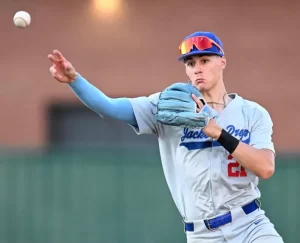With Increased Expectations, the 11th Pick Feels Different This Time for White Sox
The 2019 Chicago White Sox played only 161 games this year and it might have ultimately cost them one spot in the draft order next June. The club went 7-3 over their final 10 games and that propelled them ahead of teams like the San Diego Padres, Colorado Rockies and Los Angeles Angels in the standings. The 11th pick is familiar for the front office as they picked in the same exact spot back in 2017. The organization won too many games to close out the 2016 season and lost out on the chance to draft Brewers’ second baseman Keston Hiura as well as outfielder Jo Adell of the Angels. The White Sox ended up selecting Missouri State third baseman Jake Burger and the jury is still out due to a checkered injury history as a professional.
The organization was in a similar spot in 2015 after winning too many games to close out the 2014 season. In a draft in which Arkansas outfielder Andrew Benintendi was coveted, the White Sox missed out on their desired target by one pick and settled on Vanderbilt right hander Carson Fulmer instead. The Angels own the 10th pick in June’s selection meeting and White Sox observers are hoping that history doesn’t repeat itself. At this stage of the rebuild, picking in the 11th spot is a just conclusion to a season that bloomed in promise however.
While September baseball should generally be observed without much meaning, the way in which the franchise catapulted itself to their 72 wins is more important than the 10 game improvement from the previous season. 24-year-old infielder Yoan Moncada displayed his stellar profile by compiling 5.7 fWAR and looking every bit of what the front office envisioned when they acquired him. 22-year-old outfielder Eloy Jimenez had some ups and downs during his first big league season but the good definitely outpaced the bad. Jimenez’s plus power showed up in a big way with 31 home runs and he ended the season with a 116 wRC+. Shortstop Tim Anderson is the heartbeat of the team and won a batting title in addition to posting a 130 wRC+ while compiling 3.5 fWAR on the season.
Lucas Giolito was one of the very worst pitchers in baseball in 2018 and should be the frontrunner for Comeback Player of the Year in 2019. The 25-year-old right hander was one of the best stories in the league after looking more in line with his past prospect status. Giolito’s reworked mechanics and mindset helped him post a 5.1 fWAR season in which he struck out 11.6 hitters per 9 innings. Reynaldo Lopez and Dylan Cease offered glimpses of promise mixed in with some of the typical struggles of young pitchers. These players are all assumed members of the next core on the south side of Chicago. Winning ultimately meaningless September baseball games because of standout efforts from important future pieces is a silver lining to the waning allocation of draft related funds.
Bonus Pool Space
Under the watch of Nick Hostetler, the Chicago White Sox have spent over $22 million on their last two draft classes including dishing out well over $12 million to land premium prep talent in the 2019 haul. Hostetler has moved into a scouting role on the big league side but the shift in draft philosophy and recent spending trends shouldn’t change too much in 2020. Mike Shirley was recently promoted to Director of Amateur Scouting and while some tangible change could occur behind the scenes, it’s business as usual for the White Sox as far as the draft is concerned.
The organization won’t be able to spend as much money on their 2020 draft class but they can still go over by 5% of the total bonus pool to extract as much talent as possible. In 2019, the #11 overall pick had an assigned slot value of $4,547,500 and that’s likely to increase for next year. While the figures aren’t out yet, it can be reasonably estimated that the total bonus pool for the White Sox should be somewhere in between $8-$9 million in all. It’s entirely too early for a mock projection in regards to a team picking in the 11th slot, but Baseball America recently gave the world a glimpse of what they think the top 10 would look like today.
The Detroit Tigers and Kansas City Royals are picking 1st and 4th respectively in the 2020 Draft and the White Sox’s decision makers are likely fine with their club’s ascension past the division rivals. In addition to the Tigers and Royals, the Baltimore Orioles, Toronto Blue Jays, Seattle Mariners and the aforementioned Angels are also American League clubs that finished with a worse record than the White Sox. With a cost-controlled young core and a farm system still ranked very highly by most publications, the Sox should be pushing some chips in for 2020.
Busy Off-Season Ahead
The 2019 White Sox didn’t get much production from right field or designated hitter and General Manager Rick Hahn recently bemoaned the lack of production when offering a glimpse of his off-season plan. Hahn’s club also finished in the bottom 10 in all of baseball in home runs and on-base percentage while simultaneously finishing last in the league in walk rate and first in singles amassed. Hahn acknowledged that offensive reinforcements are likely coming this winter and a philosophical change is in order as well with the recent ouster of Todd Steverson after spending six years as the club’s big league hitting coach.
The outfield is a concern for the White Sox and while the position is a strength of their farm system, many of those players aren’t ready to contribute at the major league level. “As we sit here today, many of our young outfielders aren’t quite ready to fill that void in right field. That could well be an area we need to go outside to address“. Nicholas Castellanos, Marcell Ozuna and Yasiel Puig are the top free agent right fielders available this winter. While any of the trio would be an improvement on the club’s paltry production in the corner, a left-handed option would be a better fit. Hahn echoed similar sentiments in regards to their already righty heavy lineup in saying, “Ideally, you’d like to balance that out, and that would require adding some left-handed power”.
Left-handed power is at a premium and there aren’t a plethora of readily available options on the market in the upcoming period. Corey Dickerson (136 wRC+ vs RHP) is likely the best option in free agency. Kole Calhoun (112 wRC+ vs RHP) of the Los Angeles Angels is another player who could be available and ready to switch clubs. On the trade market, a guy like 37-year-old Shin Soo Choo (127 wRC+ vs RHP) of the Rangers could be a fit as well despite his poor outfield defense. Joc Pederson (137 wRC+) of the Dodgers is another year closer to free agency and those talks could be reignited by the White Sox as well.
While lineup balance is important, Hahn reiterated that they don’t want to be become slaves to handedness when building the best roster for 2020 and beyond. “We don’t want to get too hung up strictly on handedness in the end and sign an inferior, say, left-handed hitter when a better right-handed hitter is available and fits“, said Hahn. J.D. Martinez has been a rumored fit on the free agent market for the White Sox and he would fit this description. The 32-year-old slugger is likely to opt-out of the remaining three years and $62.5 million owed to him in Boston. It can be expected that the lineup will be upgraded in immense fashion but there are issues in the pitching department as well.
Hahn sang the praises of Lucas Giolito and Dylan Cease while expressing belief in the future performance of Reynaldo Lopez as well. Michael Kopech will be given the opportunity to earn a job in spring training and Carlos Rodon will return to action at some point during 2020 too. Dane Dunning and Jimmy Lambert are currently rehabbing separate elbow injuries as well but could be part of a future rotation with the Sox. Adding more pitching this off-season however is likely to be another focus of the front office. Hahn mentioned the need for two starting pitchers and some bullpen help as well which isn’t atypical to the rest of the industry.
The Time for Draft Pick Forfeiture
There’s no such thing as having too much pitching and the White Sox quite literally ran out of starting pitching to close out 2019. That likely won’t happen again. Astros’ righty Gerrit Cole and Giants’ southpaw Madison Bumgarner are the top free agent starters on the market. Stephen Strasburg of the Nationals can elect to become a free agent as well. Lefty Dallas Keuchel of the Braves will re-enter the marketplace in addition to them. Jerry Reinsdorf doesn’t have a history of splurging on pitchers and there’s no reason to believe that his thought process will change. The White Sox currently have a payroll of around $23 million committed to the 2020 roster before arbitration raises are settled. They have money to spend and Hahn has stated emphatically that it will be spent.
Zack Wheeler of the Mets, Jake Odorizzi of the Twins and Alex Wood of the Reds are seemingly more realistic targets in the pitching department than the top names available to the White Sox. Filling out the pitching puzzle will be an interesting chore for the front office to conquer this winter. With a surfeit of uncertainty in the bullpen, relievers could be another area of focus for the club this off-season. Aroldis Chapman and Dellin Betances of the Yankees could be available as well as the Giants’ Will Smith among others.
While it was never discerned publicly, the White Sox have stayed away from free agents with compensation attached in recent years. The organization wasn’t in a place where forfeiting draft capital made logical sense. Their fortunes have now changed. With the dearth of quality in the American League, it is now time for the franchise to strike and feverishly upgrade the roster for 2020 and beyond. Drafting and developing will always be important and they’re essential to remaining competitive in the long-term. Picks in the fifties or later should no longer be prioritized over the addition of impact talent at the big league level though.
Players like J.D. Martinez, Stephen Strasburg, Marcell Ozuna and Zack Wheeler should be attainable but will have free agent compensation attached to their value. If the White Sox sign a free agent who has turned down a qualifying offer, they will forfeit their 2nd round pick in addition to the bonus pool associated with that selection as well as $500K in international pool space. In the case of the White Sox, that would likely mean the forfeiture of a draft pick in the 49-52 range and the $1.3 million or so associated with that slot. If the organization signs multiple players who received a qualifying offer, the compensation increases in successive fashion.
Qualifying Offer Rules for White Sox
- 1 QO free agent signed: White Sox forfeit 2nd round pick, bonus pool and $500K in international space
- 2 QO free agents signed: White Sox forfeit 2nd and 3rd round picks, bonus pool amounts, $1 million in international space
- 3 QO free agents signed: White Sox forfeit 2nd, 3rd and 4th round picks, bonus pool amounts, $1.5 million in international space
The 11th overall pick is protected in free agency under the most recent adaptation of the rules agreed upon in the latest collective bargaining agreement. Mike Shirley will definitely get to make one really important selection next June. The depth of the next draft class and the amount of money spent on it might be decided this off-season though. Adding impact young talent to an organization is of the utmost importance but the big league team will no longer finish last in the pecking order on that scale. Draft compensation might turn from prized possession to collateral damage in short order and that’s a positive development for the organization at this juncture.
Follow James on twitter.
Want to know right away when we publish a new article? Type your email address in the box on the right-side bar (or at the bottom, if on a mobile device) and click the “create subscription” button. Our list is completely spam free, and you can opt out at any time. Also, consider supporting FutureSox on Patreon! You can get early access to special articles and Patreon-only posts, in addition to more benefits you can read about here.







Rodon is not coming back in 2020. That would be 1 year in June/July. It takes 1 1/2 years to come back from T.J. surgery.